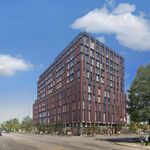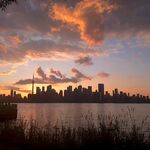A related article from the Star on trees in the burbs:
Why suburbs will never have tall trees
May 7, 2006. 07:18 AM
KENNETH KIDD
Drive through the outer suburbs of Toronto, and chances are you'll find a familiar scene, one replicated across the continent.
Behind the signs announcing a new subdivision, monstrous tractors and earth-moving equipment will be chugging across the landscape, preparing what might have been a farmer's field for a sea of houses.
Off to one side, there'll be a giant pile of earth — all of the topsoil that had been scraped away and set aside so the machines could grade the site for drainage, sewers and roads.
Then the houses duly go up, some of that topsoil gets put back for the lawns, and in come the happy new homeowners dreaming of a green and leafy suburb to be.
There's just one snag: It may be decades before the place will begin to support the kind of trees the homeowners want.
"It's really not the first generation of trees that's going to be this spectacular canopy that you see in those old neighbourhoods of any town or city," says Richard Ubbens, chief of urban forestry for Toronto. "It's going to be the second generation that starts to form that canopy."
In other words, it could take more than a century — and generations of homeowners — before that subdivision starts looking like verdant Riverdale.
The problem: The kind of soil that trees need and the way they actually grow both happen to run counter to a lot of popular misconceptions, and headfirst into modern building techniques.
This is why Todd Irvine, an urban forestry consultant with Bruce Tree Expert Company Ltd. in Toronto, is pointing to his forearm.
When they're small, "Roots are as small as the hairs on my arm," he says, "and people don't necessarily realize that. They think of them as these big things pushing through cement, and they're not."
In order to grow, the roots of trees need soil that contains a lot of oxygen and free space, not just water and nutrients. They also need room — or rather, a special kind of room. The roots don't go very deep, with most of them in the top 60 cm or so. So they try to spread out as far on all sides as the tree is tall.
Now consider what's happened at the subdivision. Once the topsoil is removed, you're left with the rock and clay underneath, which hasn't seen the light of day for thousands of years. Landscapers call it "hardpan," and from an engineering point of view it's an ideal material to mould into the site's drainage plan.
Run heavy equipment over material like that, and it quickly gets compacted into something with much the same consistency as concrete.
Once the houses are in place, the topsoil gets put back, but usually to a depth of only 20 cm., which is the typical municipal standard and enough to support healthy turf.
The rest of the stockpiled topsoil is usually sold off and eventually ends up in nurseries, but only after it's been rehabilitated by adding manure or peat moss or sand. That's because the soil became anaerobic after sitting in a pile for so long. "There's no oxygen within that pile anymore, and eventually all the living microbes and organisms in that soil die," says Ubbens.
So you end up with less-than-ideal topsoil spread thinly over a layer of clay hardpan that often includes pieces of brick and other debris. "In our business, we call it `builder's loam,'" says Ubbens. "It's unfortunate that it's so bad that it's even got a name."
Planting trees in that is like sticking them in a clay pot. "We bore a hole in that heavily compacted clay, put the tree in with a certain amount of soil, but the tree will eventually start to decline," says Andy Kenney, senior lecturer in urban and community forestry at the University of Toronto.
Sometimes, those holes can fill up with water, drowning the tree. Or the roots, unable to penetrate the surrounding clay, will keep circling around and end up girdling themselves. Even those that manage to survive will be stunted.
Irvine's parents live in a Mississauga house built in the early 1970s as part of a new subdivision, for instance. It used to be an apple orchard, and not long after the houses went up, in came new trees planted in the boulevard.
"There are Norway maples in front of their house that should be 50, 60 feet tall," he says. "They're 10, 12 feet tall."
Why then, are the trees in places like Riverdale, High Park or the Beach so tall?
It's partly a function of how the houses were built, and the technology available a century ago. Armed with only small steam shovels, horses and manpower, developers essentially plopped houses onto the existing terrain. The original grade of the land, and much of soil, was left untouched, and a lot of the existing trees were spared, says Ubbens.
"So you have these unique communities in older parts of towns and cities, not just Toronto but all over the place, where one house is higher than the next because there were hills and valleys and little undulations in the terrain."
That's why older neighbourhoods had to be dotted with little pumping stations to handle water and sewage, which wouldn't otherwise flow the way it needed to go, and why there'd be variations in water pressure. Quaint in the city, perhaps, but not the kind of selling point that gets highlighted in the brochures for a new subdivision.
There was another advantage in the way builders operated back then. Not just the soil, but the structure of the soil was left intact. The ideal planting medium, says Ubbens, also includes a gradual transition from the topsoil down to the underlying material, rather than a sharp divide between topsoil and the more mineral-laden soil underneath.
That transition has been built up through the work of decaying plant material, frost, worms and the like. Recreating it isn't easy. "If you're dealing with a clay soil, that soil can be pretty hard and tough, and it can take decades and decades before you have any kind of decent soil profile again," says Ubbens.
To wit: his own house in Rexdale, built a half-century ago. "I'm starting to see a little bit of soil profile around my place," says Ubbens. "My piece of property was graded, originally, so I'm not one of the lucky ones."
Some trees grow well on less hospitable sites, such as ashes and honey locusts, which is why you tend to see a lot of those in new subdivisions.
And there have been surprises. Silver maples usually do well in wet soils but somehow seem to survive in drier, compacted soils. One theory, says Kenney, is that with their normally wet feet, these maples were already adapted to deal with lower levels of oxygen in the ground.
But relying on a relatively limited number of species has its own potential problems. The number of ashes that have been planted, for instance, is an open invitation to the emerald ash borer, now wreaking havoc around Windsor and working its way east.
Tony DiGiovanni figured he knew better when he bought his house in Newmarket. He is, after all, the executive director of Landscape Ontario, the umbrella body for the landscaping industry.
"I was smart enough when I went to buy the house that I put in the offer that I wanted a foot of topsoil.
"First of all, the agent looked at me as if I was crazy, and I said, `No, I want a foot of topsoil.' It really doesn't cost that much to put a foot of topsoil on."
It proved a fleeting victory. "What happened was that, after the topsoil was down, they drove these huge machines over it, so they compacted it like cement anyway."
DiGiovanni ended up having to till it all up himself and bring in additional topsoil. "In retrospect, I look at it and say, `You know, it's impossible for these guys to build the way they build without these machines,'" he says. "You need the machines."
There are solutions, but soil quality isn't top of mind for most homebuyers, if it occurs to them at all. It's all hindsight. "If they knew they were buying a house where it was going to be that difficult to grow things, I think a lot of homeowners wouldn't be happy about that," says Irvine.
"They just think they're going to get soil, and soil is soil is soil. But it's not."
Nor has soil got a lot of attention from municipalities and homebuilders. The Greater Toronto Homebuilders Association, for example, doesn't have any soil guidelines. It relies instead on the municipal standards in various communities, which are only now being revised to be more tree-friendly.
In Toronto, Ubbens says his department is pushing to have the minimum topsoil standard raised to 30 cm., or about a foot, from the current 20 cm.
But he knows policing any new standards will be tough. "I don't have the staff to go onto private property and supervise the installation of top soil."
And the ultimate solution — machines called "sub-soilers" — won't be common anytime soon. There are a variety of sub-soilers, but the basic idea is the same. Think of a giant tooth cutting a metre into the earth and vibrating, breaking up all that compacted soil.
The City of Toronto uses them on its new planting sites, then mixes in additional peat moss or sand before putting about 15 cm. of mulch on top. "What you get is this incredible root growth," says Ubbens. "It just allows the roots to get down and get established very, very quickly."
DiGiovanni doesn't need convincing. "Sometimes, I think if we could just do one thing to improve the environments in subdivisions, it's the sub-soiler."
But sub-soiling is expensive, and it has to be done after the houses have been constructed, so you have to worry about cutting into any underground utilities. "I don't know anybody who's doing it now," says DiGiovanni.
As Irvine puts it: "Arborists are pretty low on the totem pole. You have a site where you have architects, engineers, lawyers, urban planners, traffic consultants.
"Arborists don't have that clout. But if we want to live in healthy neighbourhoods, a big component of that is big trees."
AoD




